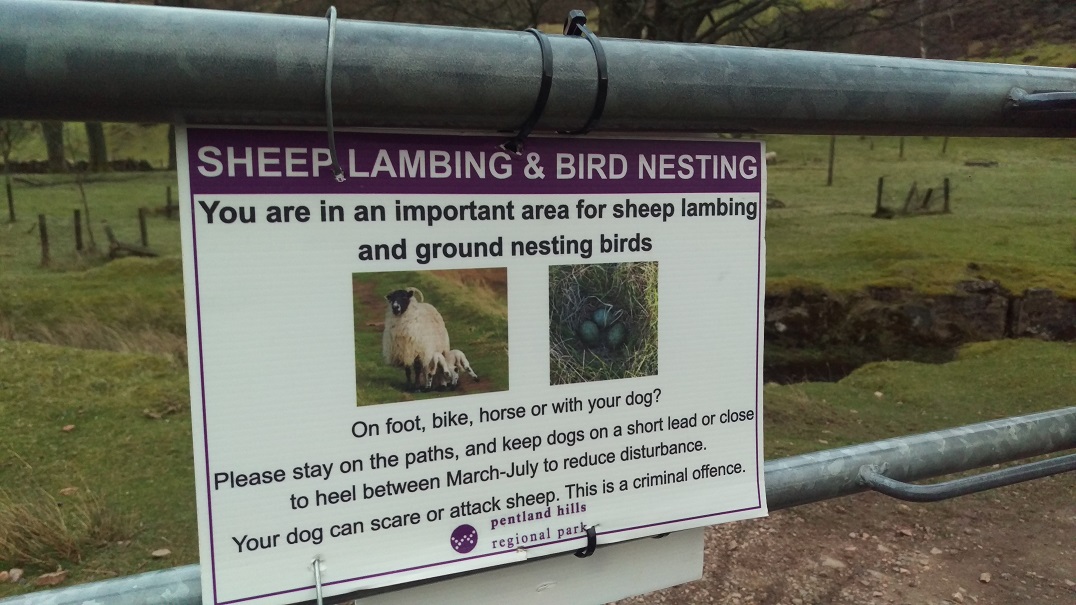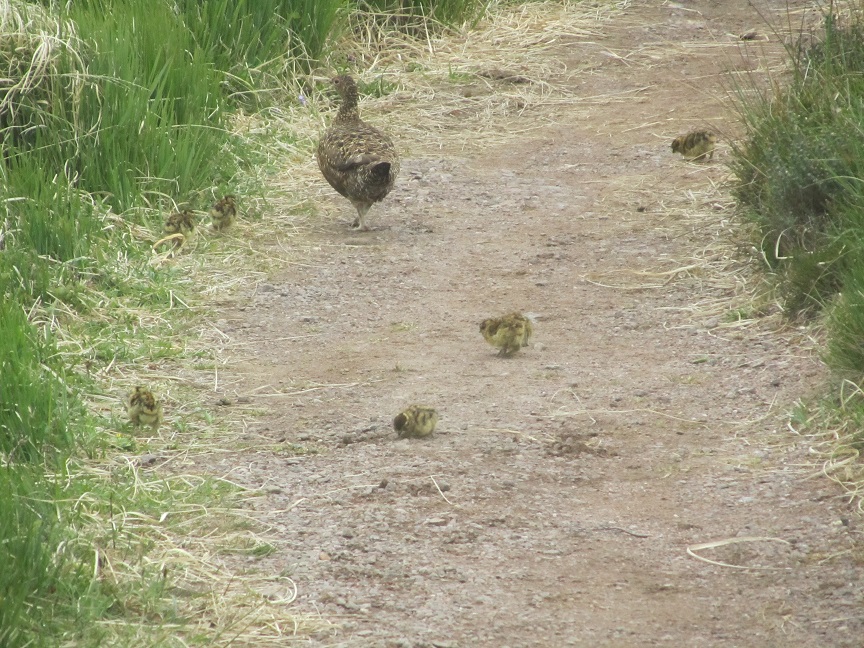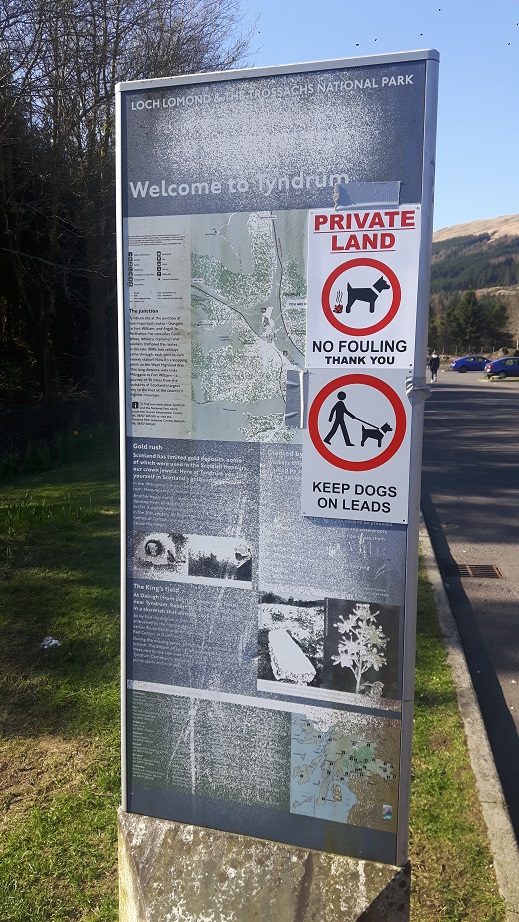
Following Dave Morris’ post (see here) on how the Cairngorms National Park Authority are trying to restrict access to paths, parkswatch has been sent some more photos of unlawful signs by readers. When a National Park, which has a privileged place on the National Access Forum, believes its alright to issue a news release telling people to stick to the Park, its hardly surprising that other authorities follow that lead. The sign above, from the Pentlands, has apparently gone up in the last year.
Like the Cairngorms National Park Authority news release, the sign appears prompted by concerns about dogs. To give the Pentlands Park credit, they give greater recognition to the fact that dogs can be kept under close control without being on a lead. That is consistent with the Scottish Outdoor Access Code, unlike the first section of the CNPA news release that called for all dogs to be on a lead at all times (later on there was a reference to “close control”. The Regional Park was also quite correct to advise that if a dog attacks sheep this is a criminal offence. Their advice, however, to keep to the path is not compatible with the Scottish Outdoor Access Code, whether or not you have a dog with you. The sign is therefore unlawful.
Its also stupid. What happens if you are walking along a path and the sheep are on it?
Request to “keep to the path” advice reminds me of the immediate aftermath of the Foot and Mouth crisis, which preceded our access legislation. It had been a frustratingly good winter and when the National Trust for Scotland “re-opened” part of Glen Coe I went with a mate to celebrate the lifting of the restrictions with an ice climb. By the Coire an Lochan car park there was a map indicating walkers and climbers should stick to certain areas which were accessed by a narrow hatched strip by the path to the bridge. That hatched area was the only one where we saw sheep all day!! The responsible thing to do was to ignore the signs and outflank the sheep by entering the restricted area, so we did.
The Scottish Outdoor Access Code provides similar advice in relation to dogs:
“If you go into a field of farm animals, keep your dog(s) on a short lead or close at heel and keep as far as possible from the animals”
That might mean avoiding the path and squelching through mud!

Its the same with wildlife. Sticking to the path can sometimes be irresponsible. Normally, whether or not you are on a path, if you are are disturbing wildlife you will be made very aware of this. Thinks of the distress calls of lapwing and other waders if you get too close and how their flight is designed to lead you away. Think of the dotterel or Ptarmigan on the high tops which again try to lead you away from their nest or chicks with their broken wing trick. The call in the CNPA news release to stick to the path on the summits to avoid disturbing dotterel was nonsense. What they should have been saying is if you want to avoid disturbing wildlife, look and listen. And, if your dog has not been trained to stay at heel whatever crosses its path, keep it on a lead.
Access Authorities and access managers need to be clear, access rights extend to all land except that listed in Section 6 of the Land Reform (Scotland) Act 2003 as being exempt from access rights (the curtilage of buildings, industrial sites, land with crops etc). They also need to understand that there is nothing in the legislation or the Scottish Outdoor Access Code – except in very specific circumstances (think of the path through the tern colony on the Isle of May) – which says its more responsible to keep to a path than to step off it. There is a very good reason for that. Your ability to enjoy the countryside would be enormously constrained if the only places you could go were on paths.

Despite our rights of access, signs such as that above which say “private land” or “private road” still make me feel uncomfortable. They are not welcoming. Why above the perfectly reasonable “No fouling” message, is there a heading “private land”? It feels designed to make people feel insecure. What’s the difference between dog fouling on private land and dog fouling on public land? Aren’t both equally antisocial? So why say the land is owned privately?
I have never owned a dog and am not a doggy person but dog owners have rights under the Land Reform Act.
“Access rights apply to people walking dogs as long as their dogs are kept under proper control.”
Not necessarily on a lead, and not just on a path, but under proper control.
There are of course too many dog owners who venture into the countryside who are don’t know how their dog will react to wildlife because they have not been properly trained. Last year on two occasions I witnessed dogs out of control, one of which involved a dog chasing a sheep for several minutes in the Lake District. It was a distressing experience and the dogs’ owner was clearly completely out of their depth as they tried to catch their dog. If a farmer had been present with a gun I would have understood had they shot the dog.
Rather, however, than saying “no dogs” or “dogs need to be kept on a lead” or “keep to the path” we need more sophisticated messages. The Scottish Outdoor Access Code should have provided the framework to develop these but instead, public authorities and access managers have been promoting their own simplified versions of the law. Here are a couple of my attempts at messages which I believe are more in the spirit of SOAC:
“Be aware of farm animals and nesting birds – if you don’t know how your dog will react to domestic animals or wildlife, keep it on a lead”.
“Enjoy the wildlife but adapt your route if their behaviour indicates you might be getting too close”.
If you see a sign that contravenes access rights, ignore it, report it and complain! I have passed the Pentlands Sign on to Ramblers Scotland and will report the Tyndrum sign to the Loch Lomond and Trossachs National Park Authority.
